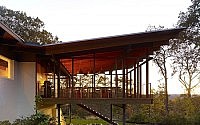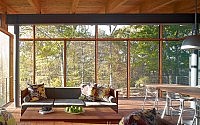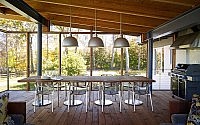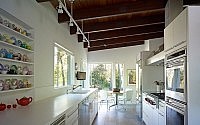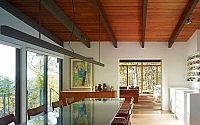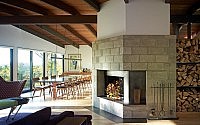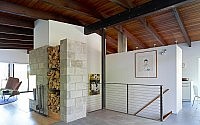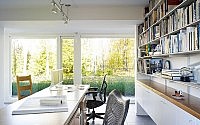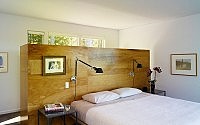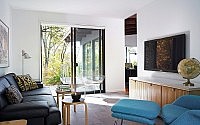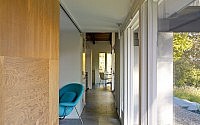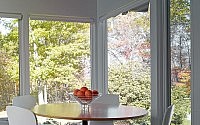New Milford Residence by Billinkoff Architecture
New Milford, Connecticut contemporary residence built in 1968 completely redesigned by Billinkoff Architecture feat a 600 square foot screen porch adjacent to the dining room. Amazing!














Description by Billinkoff Architecture
This house was built in 1968, a decade too late to qualify as midcentury, and from a period considered less than stellar in American residential architecture. After her scouting mission the broker reported back, “It is a peculiar house with some very unattractive features.” She added, “It might be an insurmountable design problem, but it has great views.”
“Peculiar” it was. As one architect friend described it, the long high narrow aluminum windows inserted in the beige brick facade lent the house the appearance of a rest station in a public park. The bedroom hallway behind those windows was 52 feet long and only 32 inches wide. At its far end was a bathroom mirror that further accentuated the hallway’s narrowness and length. Fluorescent fixtures, partly hidden behind wood valances, illuminated many of the rooms. The floors and walls in the entry hall were covered in travertine. A recessed kidney-shaped planter filled with white gravel was just inside the front door. While the layout had some evidence of rationality, the rooms felt enclosed with little connection to each other or to the landscape outside.
All these design flaws paled, however, when compared to the fireplace. It was a mansard of embossed chocolate brown clay tile set on a beige brick base with a multicolored terrazzo hearth. It terminated in unresolved angles as it intersected with the sloped wood beams and decking in the ceiling. The house was less classic midcentury modern and more “design gone wild”.
Yet despite all of this, a close inspection revealed that higher aspirations had influenced some of the design decisions. Deep overhangs sheltered windows from summer sun that were positioned for cross ventilation. There was an impressive beamed ceiling and large expanses of glass with views to the Kent Hills in the distance. Contemporary detailing around windows and doors and once high-end appliances and hardware suggested that this was a custom home for a discerning owner.
Like every client’s project, cost influenced decisions and compromises had to be made along the way. But the primary goals of opening up the interior and maximizing views to the landscape were achieved.
The slotted windows at the front of the house were replaced with floor-to-ceiling glass. To further reduce the impact of the hallway, its long internal wall was reconfigured. One section was completely removed merging the corridor with a home office. Similarly the wall separating the media/guest room was removed and replaced by a 10 foot long, sliding plywood panel. Showcase bulbs in porcelain sockets mounted along the corridor were added to provide a soft glow at night and create a dynamic tableau as one approaches the house from the road. To further open up the house, full-height partitions at the entry and around the kitchen were removed exposing the stair to the lower level. In the kitchen, east facing floor-to-ceiling windows replaced the small slotted windows above what was once a small eating area.
The fireplace had been built to last. The original mason embedded the tile in concrete that formed the mansard. When it did not reasonably yield to demolition, it was decided to hide the mansard behind a screen of concrete block, blackened steel and sheetrock. At one end, steel shelves now hold firewood.
Economical finishes were used to both reduce cost and lend the house a casual contemporary feel. The floors in the hallway, bathrooms and kitchen are porcelain tile. The living and dining room floor is finished in 4 foot by 8 foot plywood with exposed fasteners. The custom kitchen cabinets are made of prefinished maple with plastic laminate fronts. The countertops are Corian. Lighting is achieved with industrial lampholders, porcelain sockets and tracks. Donald custom designed the 9 foot long dining room fixture by inserting typical undercabinet LED lights inside a steel channel.
A 600 square foot screen porch adjacent to the dining room was added. Inserted into a steel frame, the porch is open on three sides. It is perched one story above the yard and resembles an oversized tree house. The original roof pitch was borrowed, flipping it up at its far end to open the space to woods and sky beyond. It is here, in this dramatic space with beautiful views, that summer months are spent relaxing and entertaining.
The intent was not a restoration, but to reinforce the positive qualities of the house, reduce the impact of its weaknesses and achieve a contemporary feel in its spatial organization and finishes. The result is a warm contemporary home that in small ways evokes a midcentury style, and in every way, reflects the family lifestyle of its owners.
- by Matt Watts